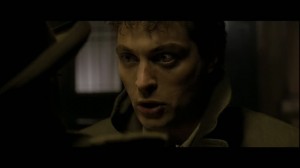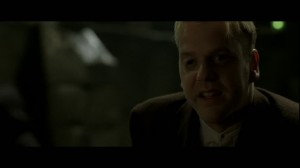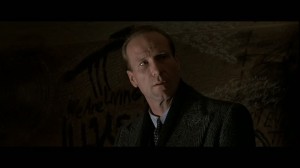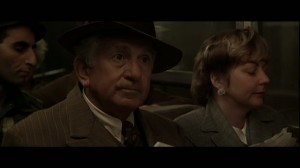Dark City
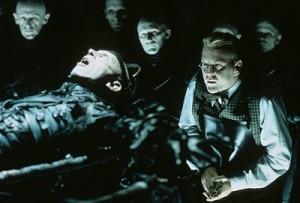
Here’s the idea behind “An American, a Canadian, and an Elitist”: Rhett’s favorite movie is “Meatballs 4″, Josh likes Hollywood pap, and Adam is a prick who hates everything. We all watch far too many movies, and spend our time analyzing them. So we each watch the same movie, write our analysis of them, and then go to a chat room to discuss it, unaware of what the others have written. A warning: if you haven’t seen the film we are discussing, it may not be best to read this article, because it is spoiler heavy.
At the time these were written, the only available version of the film was the theatrical cut, not the recently released director’s cut. Keep that in mind in terms of any points being made.
Alex Proyas is a Stranger. His film, Dark City, goes to great lengths to create a vivid and calculated visual universe, but his universe is without emotion. Like the Strangers in the film, Proyas has an expansive memory of the past, well aware of films like Blade Runner, Brazil and The Cabinet of Dr. Caligari, but his memories stop at the physical. He cannot feel the characters he creates, he feels the art direction. His world is three dimensional, but his characters are not. We are supposed to care about John Murdoch because he represents a man without a past who has been duped by the powerful Strangers. We are not shown this past, instead we are left to rely on our acknowledgement of this character cliche from works like 1984 or Blade Runner. The only way we identify with John is by the way other films have handled his character. The Strangers can remember events, but they cannot feel or understand the emotions that come with them. Likewise, Proyas knows his sci-fi noir characters, but has no understanding of them as unique characters of nuance. John Murdoch is a set piece, he looks and seems real on the outside, but as soon as you look deeper he is nothing but an empty plot construction.
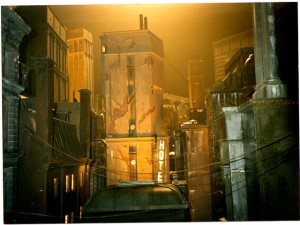 The Strangers in Dark City work by taking people’s unique identities and switching them amongst the humans until the point where their lives lack any sort of distinction or individuality, they become a mess of fragments. Proyas’ film suffers from the same fate as the humans. Dark City freely lifts from hundreds of films, a long shot from Batman here, a pinch of Scanners there, stealing so much so that it lacks any sort of individual quality of its own. The film is a collage of different films, time-frames and artistic influences, from German expressionism to film noir. With each passing moment a recycled shot from another film is thrown in, making the film very much like the city that the Strangers create. We repeatedly see new buildings erected, from different times and of different structures, but we never see inside, because those buildings are empty. Alex Proyas is a veteran of music videos, and it is fitting that his film is all style and no substance. Never letting the camera just sit and observe, he cuts his film like Renny Harlin on acid. It is as if Proyas is insecure with his lack of original insight that he instead must mask that inadequacy by cutting every second and by filling his screen with images from films that have worked in the past.
The Strangers in Dark City work by taking people’s unique identities and switching them amongst the humans until the point where their lives lack any sort of distinction or individuality, they become a mess of fragments. Proyas’ film suffers from the same fate as the humans. Dark City freely lifts from hundreds of films, a long shot from Batman here, a pinch of Scanners there, stealing so much so that it lacks any sort of individual quality of its own. The film is a collage of different films, time-frames and artistic influences, from German expressionism to film noir. With each passing moment a recycled shot from another film is thrown in, making the film very much like the city that the Strangers create. We repeatedly see new buildings erected, from different times and of different structures, but we never see inside, because those buildings are empty. Alex Proyas is a veteran of music videos, and it is fitting that his film is all style and no substance. Never letting the camera just sit and observe, he cuts his film like Renny Harlin on acid. It is as if Proyas is insecure with his lack of original insight that he instead must mask that inadequacy by cutting every second and by filling his screen with images from films that have worked in the past.
The immediate comparison here is between Dark City and Tarantino’s Kill Bill. Both are riddled with shots and influences from films of the past, and both have a hyper sense of visual style. Kill Bill however, comments on the films and genres of which it borrows, dissecting the conventions of the kung fu, blaxploitation, giallo and spaghetti westerns that it is so indebted too. Tarantino considers how women are stereotyped in such films and offers a different twist: Go Go Yubari looks the traditional school girl, but lashes out against her good-girl stereotypes with a vengeance. Kill Bill acknowledges that Asian cultures often carry patriarchal presumptions that the man dominates the woman, but he flips that convention around to show a rare moment of women in power. He uses the wire-fu aesthetic to show what kind of film he is speaking of, and then he makes his point. Dark City uses the sci-fi noir aesthetic to show that is knows how to use the sci-fi noir aesthetic.
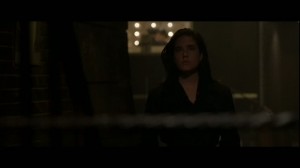 Furthermore, although Kill Bill may be sheathed in homage, it still manages to create characters that are memorable and unique. The Bride is more than just a cliche, she is a character whose struggle seems genuine and her revenge deserved. Tarantino spends many a personal moment with her, allowing her to talk and divulge her ethos. The scene where The Bride speaks to her toes, pleading that they move, is so simple yet speaks so much about her character and the struggle she must ensue. Tarantino is confident enough in himself and his ideas that he lets the scene play out uninterrupted by quick cuts or film reference. We never get that personal with Dark City. Proyas is like the Strangers in that he knows how to make something appear, but he has no idea how to understand the feeling. He knows what his character should be doing based on the experiences of similar caricatures from past films, but he has no idea what they should be feeling. The difference between Tarantino and Proyas is what makes Kill Bill a great film and Dark City a great looking film.
Furthermore, although Kill Bill may be sheathed in homage, it still manages to create characters that are memorable and unique. The Bride is more than just a cliche, she is a character whose struggle seems genuine and her revenge deserved. Tarantino spends many a personal moment with her, allowing her to talk and divulge her ethos. The scene where The Bride speaks to her toes, pleading that they move, is so simple yet speaks so much about her character and the struggle she must ensue. Tarantino is confident enough in himself and his ideas that he lets the scene play out uninterrupted by quick cuts or film reference. We never get that personal with Dark City. Proyas is like the Strangers in that he knows how to make something appear, but he has no idea how to understand the feeling. He knows what his character should be doing based on the experiences of similar caricatures from past films, but he has no idea what they should be feeling. The difference between Tarantino and Proyas is what makes Kill Bill a great film and Dark City a great looking film.
As Dark City reaches its conclusion, John Murdoch fabricates an artificial reality for himself. He remembers what the ocean should look like from billboards he has seen in the past, and fabricates his existence around that empty imagery. He has no idea what the ocean means to him, only that it looks nice. That is the essence of Alex Proyas and Dark City. His pictures have an expressive beauty to them, but they are as thin as paper. Why does John Murdoch care so much about his life; why should he care about his memories if they are all just artificial and empty in the first place? A good movie would tell us this, but what does Dark City give us? Empty buildings.
If you are anything like me, you enjoy being transported to a world wholly fantastic and theoretical. To be enveloped in the atmosphere of a movie more often than not takes precedent to all other considered filmic elements. I can forgive sub par acting, poor adherence to a three-act structure, and the ever-fleeting notion of character development if I feel that I can submerse myself in and explore a setting that is at once foreboding and inviting. It is ironic then, when I feel enthralled by a place that is a mixture of bygone eras of modern America.
I am in love with the Gotham City-esque cityscape that is the world where the Strangers conduct their experiments. Being fond of the darkness myself, both literally and aesthetically, it is no wonder I feel at home among the cinematography of Dariusz Wolski. Using an ultra-noir palette, he creates a dense arena oftentimes by only lighting with practicals i.e., table lamps, streetlights, and suspended fixtures. Through this, Wolski affects a sort of inner framing by surrounding a subject in darkness which not only establishes a visual metaphor for the characters’ imprisonment, but allows the viewer to imagine what is outside their peripheral vision by bathing it in black. It is almost as if the Strangers do not what the inhabitants to dwell too much on the anachronistic objects around them.
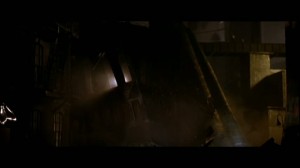 But what the Strangers do not realize is that humans are not as connected to these “pretty things” as they has assumed. Their mistake is evident when Murdoch comments on his cigarettes. “My brand I hope,” as if human immortality lies within the choice between Newport and Lucky Strike. Indeed, they are not privy to the ideas of souls and destiny.
But what the Strangers do not realize is that humans are not as connected to these “pretty things” as they has assumed. Their mistake is evident when Murdoch comments on his cigarettes. “My brand I hope,” as if human immortality lies within the choice between Newport and Lucky Strike. Indeed, they are not privy to the ideas of souls and destiny.
Of course, the viewer must have a sense of spirituality, or at least suspend atheistic belief for the duration of the film. Perhaps Dark City is a vessel for Alex Proyas’ personal beliefs about salvation and redemption. All signs point toward John Murdoch being a Christ-figure through a somewhat outworn literary technique. One does not need to be a Biblical scholar to see the similarities between Murdoch and Christ. Though he is uncertain at first to his destiny, he rejects what the Strangers impose upon him and, through his journey, amasses believers in his word. Then there is the blatant Christ pose as he lies captured.
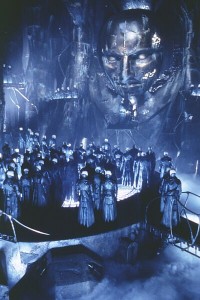 What this movie is, as is the intent of most religions, is a reaffirmation of the importance of the human soul. As with all great fantasy fiction, Dark City gives the viewer a “what-if” situation in which it is asked whether a person’s individuality can survive the withdrawal and replacement of memories. In Proyas’ vision, the soul exceeds all physical boundaries as is evidenced in the love between Murdoch and Emma, and subsequently Anna. It is almost fitting, then, that a race that does not believe in both the transience of self and the insignificance of gravity-laden things are bound to extinction.
What this movie is, as is the intent of most religions, is a reaffirmation of the importance of the human soul. As with all great fantasy fiction, Dark City gives the viewer a “what-if” situation in which it is asked whether a person’s individuality can survive the withdrawal and replacement of memories. In Proyas’ vision, the soul exceeds all physical boundaries as is evidenced in the love between Murdoch and Emma, and subsequently Anna. It is almost fitting, then, that a race that does not believe in both the transience of self and the insignificance of gravity-laden things are bound to extinction.
At first I thought it was simply poor CGI and miniature integration, but then I realized when you are aware that Sutherland (in the opening shot, standing on the bridge, when he injects the first family as the set expands behind him) and Sewell (throwing his suitcase into the water) are standing in front of blue and/or green screens, and you can see exactly how they were composited into the shot, it is deliberate. Proyas and his crew want you to gaze longingly at the enormous sets, breathe in the notion that this is a real place, and at the same time, an artifice, created by the strangers. At times it looks like a CD-ROM game (especially when Hurt chases Sewell and finds Sutherland’s card on the ground).
I still contend that Sutherland, while attempting to do his best Peter Lorre impression (the first time I saw the movie, I thought he was talking about Juning), is awful, and a huge distraction, any time he opens his mouth. He tries to play up the nasality in his voice but I kept being distracted by the thicker layer of huskiness, obviously a result of years of smoking. This was of course right in the midst of his career falling apart, heading towards direct to video projects like, To End All Wars, The Last Days of Frankie the Fly, After Alice, Ground Control , Picking Up the Pieces, Cowboy Up, and while this may have been an attempt at career resuscitation, he is lucky he found 24. The page boy haircut he has is great though. I didn’t appreciate the way that Proyas lays in the exposition through Sutherland’s babbling to himself, it’s a huge cheat.
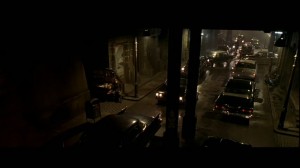 William Hurt uses the fact that in every movie he appears in he looks like he he’s either asleep or thinks he’s above the material, to his advantage. “What did I ever do to deserve this?” “No one ever listens to me.” What gets me thinking is, did Hurt take the lame-o role in Lost in Space (also New Line) to get this one, or was it the other way around? There must be a reason for the fact that Dark City cost $28 million and looks wonderful and Lost in Space (made right around the same time and released a month later) cost $80 million and looks like shit.
William Hurt uses the fact that in every movie he appears in he looks like he he’s either asleep or thinks he’s above the material, to his advantage. “What did I ever do to deserve this?” “No one ever listens to me.” What gets me thinking is, did Hurt take the lame-o role in Lost in Space (also New Line) to get this one, or was it the other way around? There must be a reason for the fact that Dark City cost $28 million and looks wonderful and Lost in Space (made right around the same time and released a month later) cost $80 million and looks like shit.
The ’50s noir thing seems less of a genre concession, than it would be the Stranger’s understanding of humans. Hence why people talk in cliches (”cash on the barrelhead”), because it only requires a simplistic understanding to convey shopworn notions and characteristics. The same goes for the lack of profanity, a subtlety that is only learned as you master the nuances of the language and situation.
There is a noticeable either editing error or unfinished effect, when Sewell uses his tuning powers to slash the Stranger’s head open. We cut to him on the ground making a lot of noise, but his head seems to be intact before the bug in his head escapes. It is actually a second Stranger clutching his head, but the shot is unclear.
The fear of water by The Strangers may seem to be about their misunderstanding of the essence of human beings, but seems more out of Alien Nation, and that whole battery acid thing. Regardless, I love the Predator noise that the Strangers make.
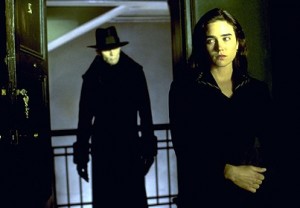 At least Proyas and company do acknowledge on the commentary their influences other than the obvious ones in Metropolis and Blade Runner, but more recently The City of Lost Children, which has a similar tone, color scheme, set design, use of row boats (especially that slow motion overhead CGI shot as Sutherland explains about The Strangers to Sewell and Hurt), though Dark City is less interested in story, character, and presenting us with consistently odd and wonderful faces, than opulent visuals and huge sets. They both achieve the creation of a completely believable alternate world, and the notion that you can’t understand humanity by simply replicating it.
At least Proyas and company do acknowledge on the commentary their influences other than the obvious ones in Metropolis and Blade Runner, but more recently The City of Lost Children, which has a similar tone, color scheme, set design, use of row boats (especially that slow motion overhead CGI shot as Sutherland explains about The Strangers to Sewell and Hurt), though Dark City is less interested in story, character, and presenting us with consistently odd and wonderful faces, than opulent visuals and huge sets. They both achieve the creation of a completely believable alternate world, and the notion that you can’t understand humanity by simply replicating it.
My favorite shot in the film, other than the shots of the rising buildings, is when Sewell is at his uncle’s house looking at slides, and discovers that his past has been made up. Angrily, he swipes at the remaining slides on the table. But all I could see was how the set was designed. Fish everywhere. Hanging above and around Sewell. Hanging on the wall, from strings. The fish were the motif in the production design.
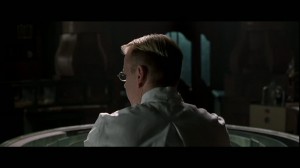 Also odd that when Sewell manages to break the glass to kiss Connelly, none of the cops have any reaction, as if plexi-glass normally shatters when prisoners talk behind them. They don’t even look up.
Also odd that when Sewell manages to break the glass to kiss Connelly, none of the cops have any reaction, as if plexi-glass normally shatters when prisoners talk behind them. They don’t even look up.
Women have limited roles in this world, either whores or sultry singers. But a limited role is sort of the nature of the film, seeing as the point is that the characters are no more than ciphers. That is both a hindrance to the film and a way out for Proyas, and while it is great that he has accomplished so much visually, the story is sacrificed. Much of my issue with the overall movie is the conclusion, where after all of those possibilities with the story, all of it is thrown out so we can watch two characters beam special effects at each other out of their heads for five minutes of screen time. It has always been confounding to me that Proyas took the easy way out, when throughout the film, he shows how creative he can be.
Adam: Ok, so I want to start with Kiefer, since I think he gives a horrible performance. Especially with the Peter Lorre impression.
Josh: How so? The breathing?
Adam: The accent, which was an attempt to be Lorre, just as nasal, but all I could hear was his smoking voice.
Rhett: Yes, he reminded me of Depp from fear and loathing, only sans cigarette
Adam: And during the opening voiceover, the first time I saw it, I thought he was talking about Juning.
Rhett: Isn’t that what he is talking about?
Adam: Yeah, Rhett, too much of a stunt performance.
Adam: It’s actually tuning.
Rhett: Potato, potato.
Adam: Well it wasn’t clear till later that’s what he was saying, since The Strangers mention it.
Josh: Yeah you’re right. Even then you’re like.. hmm. Tuning or juning.
Rhett: Was there really any performance in the film that was good?
Josh: Connelly’s, Sewell’s.
Rhett: The best performance was the ocean dock at the end.
Josh: So you guys think the acting sucked?
Adam: Why wasn’t the dock nominated for best performance by a pier? Actually, I liked Hurt a lot, since he is normally so bored and tired. He used that to his advantage.
Rhett: Not that the acting sucked. But that every character was developed only on a cliché.
Josh: Hurt is infallible in everything he’s in.
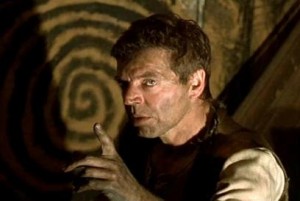 Rhett: I’ve seen all these characters before in better movies.
Rhett: I’ve seen all these characters before in better movies.
Adam: Rhett, I think that’s the idea. It’s a little cheat by the screenwriters. A little Identity magic.
Josh: Yeah, these characters are not going to be very outstanding, because their shit is all mixed up.
Adam: It’s The Strangers who only think in limited clichés, since that’s all they know. It’s a bit of a cop out.
Rhett: I mean what do we really get to know about these characters? other than the fact that the Strangers are bad and Sewell and Connelly are good.
Josh: You don’t need to know the characters well.
Rhett: I knew the sets better.
Adam: I knew the little teeth chatterer better. I think he was from Hellraiser. And The Strangers all made the Predator noise.
Rhett: Too bad none of them looked like a vagina. That was the one thing the predator had going for it.
Josh: It’s not about character development and all that shit people on Amazon bitch about in their reviews. If you notice, the difference between Connelly’s Emma and Anna is almost non-existent.
Adam: If all that distraction and invisibility didn’t work. The soldiers might have got horny and gone for it.
Rhett: I know I would have.
Adam: Well Josh, there’s the thin line, whether or not it matters that Connelly has nothing to play, since the entire idea is that she is a cipher and that her personality is manufactured.
Josh: I think it has to do with each individual’s memories being mixed up to the point that the body chooses neutral tones for everything.
Adam: Well at the end we are stuck with the reality that they get together because she’s so hot. And that’s it. No other reason, since he doesn’t really know her.
Josh: Or, is that a way of saying love transcends surface-level characteristics and lies within the souls?
Adam: Rhett, how did you see the story, as a first time viewer?
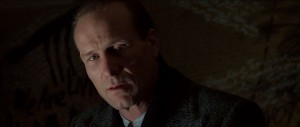 Rhett: Connelly was decent, but I preferred the dock in The House of Sand and Fog… Much more emotive. I was distracted.
Rhett: Connelly was decent, but I preferred the dock in The House of Sand and Fog… Much more emotive. I was distracted.
Adam: By her, or the dock?
Rhett: The dock.
Adam: ‘Cause that dock had a great rack
Rhett: Indeed it did, but I was distracted, because every single shot I saw was out of a different movie. And I haven’t even seen The City of Lost Children.
Adam: I can’t argue with that. At least they acknowledge that on the Dark City DVD, with all the stuff comparing it to Metropolis. I did think that the building’s rising was original, especially when that guy gets squished.
Rhett: The city is Gotham city, the forehead drill is from Scanners, that circular table is from Lawnmower Man, billboard sequence from Blade Runner, etc.
Adam: But what about the fishes? Where are they from? That was my favorite shot in the film, when he’s at his uncle’s house and he gets pissed about the phony slide show and knocks all the slides off the table, and they cut to a wide shot and there are fish everywhere, hanging above him, attached to the wall.
Rhett: Don’t get me wrong, I thought it was a beautiful movie. But an empty one.
Josh: THESE ARE ALL LIES.
Rhett: The whole fishtank metaphor has been done to death.
Adam: I don’t think this was even a metaphor. It was just a fetish by the production designer. He’s a fish fucker.
Rhett: Sure, it is. The fish have nowhere to go, stuck in a constructed reality. It was product placement by Disney anticipating Finding Nemo, just like all those Dreamcast signs in the carved up chicks.
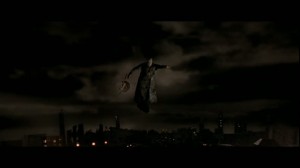 Adam: In the opening scene, sure I can see the fish metaphor, but I am referring to the later scene.
Adam: In the opening scene, sure I can see the fish metaphor, but I am referring to the later scene.
Josh: What do you see the opening fish metaphor as?
Rhett: Swell saves the fish because he recognizes his own vulnerability.
Josh: Murdoch “waking up.”
Rhett: Yes, definitely Josh. When he knocks the fish over he finally sees the outside world, able to understand what he never could before.
Adam: I have a practical question then. Since Lost in Space and Dark City were both New Line, and they opened within a month of each other, and Hurt had a big role in both. Which did he do for the money?
Rhett: I think Dark City would have been more interesting if it were just an actual collage of shots from all the films that Proyas was obviously influenced by instead of just aping the shots, if he just cut them right out of the films.
Josh: Yeah, but you never honestly know. I come up with things that have been done before when I have no knowledge of the same thing ever existing.
Adam: What I found most interesting about the visuals was that the CGI was never really convincing. And I think it’s on purpose. I think Proyas wanted all to see the artifice. The blue screen work is bad purposefully, since one of his themes was the artificial recreation.
Rhett: The CGI was really no better or worse than the other films of its time.
Adam: The opening shot, where Kiefer is standing in front of the bridge, the composite is very poor and obvious. Or when he injects the family as the set expands around him. Or when Sewell throws the suitcase in the water.
Josh: Yeah, I think Rhett’s right. I don’t think any director as visual as proyas what’s his effects to look hokey.
Adam: Oh, I liked the fact that I noticed the strings. I think it may have been slightly intentional. The movie looks a lot like a CD-ROM game. A computer’s version of reality, thus The Stranger’s version.
Rhett: I doubt it. Proyas comes from the Michael Bay school of filmmaking, all style, and so underconfident with his story that he never dwells on a shot for more than a couple seconds.
Josh: It’s not a computers version of reality. It’s all organic. I’m calling bullshit on that Rhett.
Adam: Well Proyas does cut an awful lot.
Josh: Yeah, but there’s also a lot of brooding substance there.
Rhett: It is definitely better than Michael bay, but in the same vein.
Josh: If you notice though, the editing in DC slows down near the end.
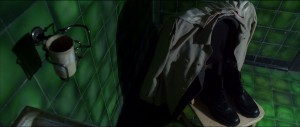 Adam: Yes, the editing slows down, and it’s not like a Bay or Luhrman headache. The cutting in Dark City seems to have a purpose rather than cutting around your mistakes and ineffectiveness as a filmmaker… In terms of the look, I’d say that Escape From LA, the effects are intentionally comic book looking and hokey
Adam: Yes, the editing slows down, and it’s not like a Bay or Luhrman headache. The cutting in Dark City seems to have a purpose rather than cutting around your mistakes and ineffectiveness as a filmmaker… In terms of the look, I’d say that Escape From LA, the effects are intentionally comic book looking and hokey
Rhett: The effects are dreadful in LA, so bad that it had to be intentional. I thought the ironic thing was that even though Dark City steals from everything, it has been pretty influential itself. The now-trademark Connelly pier shots, and the memory flashbacks were almost identical in Minority Report.
Adam: I hated the ending of Dark City. Not the Shell Beach portion, but the part where Sewell faces off and it’s a battle of heads. After all that interesting imagery, derivative or not, we get a dunderheaded effects show.
Rhett: Sewell was literally the fish out of water the whole time, and Proyas never lets us know why or even really care about him.
Josh: I was never convinced Bale wanted to be the savior of the resistance. You knew Sewell wanted to straighten things out, he had a lot more to struggle with. We care about him because we want to see him succeed, we want to see him free the humans living in his city.
Rhett: Okay, but how does he free them? All he does is create another artificial reality, only it has water and a sun. The ocean still means nothing.
Josh: But it gives the people a chance to become who they are instead of ripping their memories away the next day.
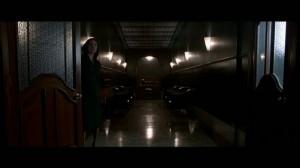 Rhett: Why are we to believe progress has occurred? He sets up a coastal suburb… The film suggests that the city is bad and rural life is good.
Rhett: Why are we to believe progress has occurred? He sets up a coastal suburb… The film suggests that the city is bad and rural life is good.
Josh: You’re to believe progress WILL occur… Wait, how does it suggest that cities are bad?
Adam: That the city is repetitive and always dark and the suburb is the sanctuary.
Rhett: Well why is his triumph at the end good? Because he creates an ocean and a coastal village.
Josh: Because he destroyed the creatures that controlled his fellow man.
Rhett: Nobody has their own memories anyway, so what does it matter?
Josh: No, but in time they’ll create their own. The film doesn’t force-feed you an ending.
Adam: And they are all going to have permanent dots on their head from all those imprints.
Rhett: He creates an ocean which gives people the idea of expansion, but really, they are still all in that little fish tank.
Josh: You need to imagine what happens next, now that they can actually live a life.
Adam: They’re all going to be Indian women.
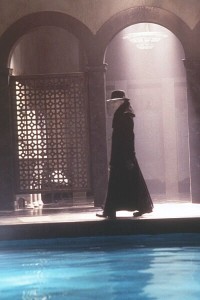 Rhett: But we’ve seen their world, it is a little orbit in space. It is like a space age Truman Show universe.
Rhett: But we’ve seen their world, it is a little orbit in space. It is like a space age Truman Show universe.
Josh: But in time, who knows, they may realize that they have come from a different place. Do you think they’re better off being controlled by the Strangers?
Rhett: Oh, and how do they have atmosphere there?
Josh: How the fuck should I know. How do they make buildings rise like boners?
Rhett: It is Freudian. They have Sigmund Freud caged up in a basement
Adam: There are no female Strangers. Perhaps it is a dick measuring contest.
Rhett: Like in Last American Virgin. See? It steals from that too. And why does this advanced Strangers race always have to yell “Sleep!” whenever they knock people out? It reminded me of a bad zombie movie. “Brainnnnnnnnnnns.”
Josh: It’d be funny if they did that for every command.
Adam: “Masturbate.” “Defecate.”
Josh: “Bake cookies.”
Adam: Josh, you said earlier that the people of the city would discover themselves eventually. There’s one scene where that may not be true. When Sewell kisses Connelly through the glass and it breaks the glass. The cops had no reaction, as if this was an every day occurrence. “Oh yeah, the perps always break through the plexi glass with their mind.”
Josh: Don’t they run in and grab Sewell?
Adam: They don’t grab him.
Josh: Yes they do, ’cause then how does the scene end?
Rhett: They just casually walk up to him and take him away.
Adam: They don’t even seem to notice anything out of the ordinary. It says to me that even in a new environment, these people won’t have any emotions
Josh: Not right away. But human beings by nature are adaptable.
Adam: Well, you said earlier that the people only live on their instincts, but they didn’t even react.
Josh: Well I can’t speak for that scene. Maybe it was just really shitty blocking.
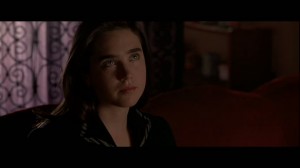 Rhett: So is the movie really anything more than a music video?
Rhett: So is the movie really anything more than a music video?
Josh: Of course.
Rhett: It just seems to be about what is on-screen.
Josh: For you, perhaps. But after I turned it off, it was still in my mind and I thought about it for some time. And I often think about it.
Adam: How so? And about what specifically?
Rhett: For me, none of the characters were distinctive or original enough to linger on.
Josh: The possibilities of alternate realities. Are we really living free lives right now?
Are we perhaps under someone else’s control?
Rhett: I’ve seen it in Blade Runner, 1984 and Brazil before.
Josh: And now you’re seeing it in a different light.
Rhett: Yeah Josh, if anything the comic book revival of the 90’s really explores the idea that our reality is a constructed one.
Josh: This film is much more about the soul than freedom of choice. Who cares who did what when? You can’t possibly see every film, read every book, listen to every album. Yes, there are going to be overlaps. When I saw Dark City, it was among the first I’d seen of things of that nature at that time. I was 15 when I first saw the movie, very young, and I was very impressionable. That’s like saying you’re not going to see a love story because two people are in love. Oh, well, that’s been done before hasn’t it?
Rhett: But Dark City overlaps so much. It is more than just coincidence… So this ties in with the idea of nostalgia skewing one’s opinion on a film.
Adam: And why Meatballs 4 is better than Citizen Kane.
Rhett: Exactly. A love story can be told over and over again if it takes the time to develop the characters, make us feel as if we are watching something different. Dark City did not do that for me. The characters were set pieces. Plot devices, rather than thinking and feeling beings.
Josh: Alternate reality stories are still somewhat new. If there were as many Dark Cities are there are malls, then you have something to bitch about. And yes, perhaps Dark City borrows from other films… At least you can see it that way. But holistically, its style is original.
Rhett: But what does it have to say that hasn’t been said before?
Josh: Rhett, when was the last time you’ve seen a movie that said something 100% entirely original?
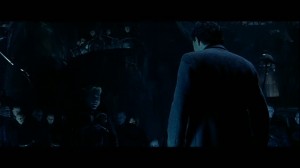 Rhett: You’ve Got Mail could at least comment on the internet revolution by updating The Shop Around The Corner for a modern setting. Dark City could comment on the fact that Proyas liked Blade Runner.
Rhett: You’ve Got Mail could at least comment on the internet revolution by updating The Shop Around The Corner for a modern setting. Dark City could comment on the fact that Proyas liked Blade Runner.
Adam: It’s interesting that the movie is about how The Strangers can’t seem to understand the heart or understand real emotion, and yet we don’t feel anything emotionally about the supposedly human characters.
Josh: Rhett, If you’re going to talk about the internet, I’m going to say boo to that because Neuromancer did the internet best. And as far as I know, that’s never been explored.
Adam: It was in Johnny Mnemonic. Because I care what Cyborgs think about room service.
Josh: No, William Gibson coined the term internet for Neuromancer, in which case we should be bitching about AOL’s lack of originality.
Rhett: See, at least Johnny Mnemonic had Dolph Lundgren.
Adam: And no movie is complete without both Ice-T and Udo Kier.



